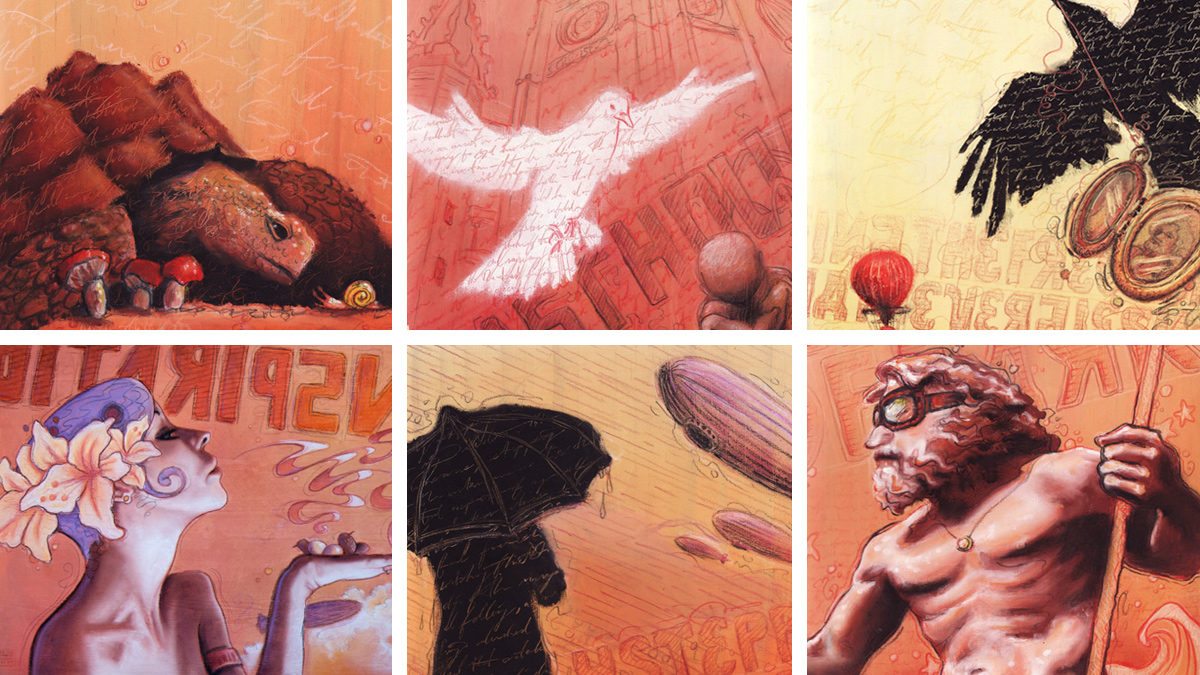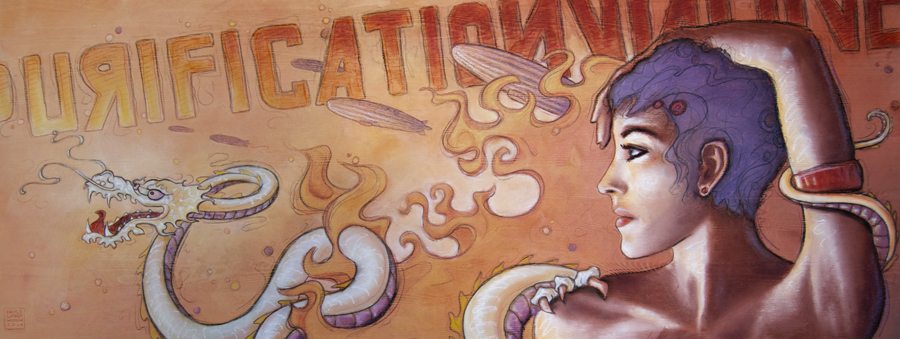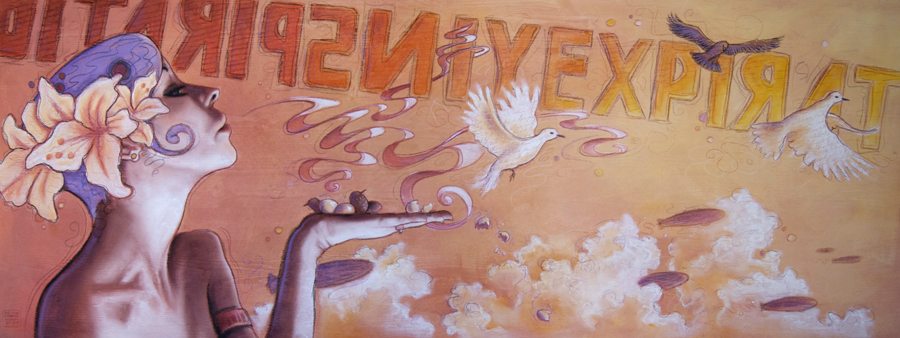Widom’s series thus discloses an ethic of ground value and the revelation of Each and Every as Spirit — a redemptive move, as we shall see, for both post/modern art and postmodern culture itself. Color fields of beige, tan, and reddish tones suffuse the whole; figuration and scripts manifest in shallow if an indeterminate space; the gently radiating void-space permeating, saturating, and containing all forms – a visual metaphor for the relationship between emptiness and form, between formless Spirit and the manifestations that are not other than source. That these ground tones then are not the intense or ethereal hues normally associated with spirited expression points to the earthiness and fleshiness of the artist’s sense of non-dual realization (the color fields themselves resonating in tone with the unframed materiality of the wood panel supports), pointing us to the radical (re)embodiment of Spirit — the healing of what Saniel and Linda Groves-Bonder call the Great Matter/Spirit Dissociation of our collective human inheritance. And, too, Widom’s vision is inseparable from a certain recognition and embracing of the Feminine Divine, women and goddesses as the principally depicted human forms, associated as they are via a variety of pictorial means directly with earth or with the tonal ground itself (e.g., No. 10, No. 3, No. 13); whereas male figures have a more mediated relation to the pervasive tones and ground — symbolically (e.g., the stars of No. 10 and No. 12) and more discretely as separate form (e.g., No. 12).
By working within a self-delimited set of parameters, Widom creates a set of paintings where the various elements and motifs, in their shifting combinations, generate a “visual grammar” internal to the series, a “language” proper to 1000 Views of God that, as we intuit it (however non-consciously) through sustained engagement with the works as a whole, deepens our attunement to the expressive nuances of any given painting. We enter the linguistic gestalt of the artist and his work.
This self-generated “visual grammar” itself partakes of the broader lineages of pictorial montage/collage, the gathering together of imagery and text where the respective material signals a wide variety of source traditions and cultural spheres to which it seems to belong or from which it seems to originate. Collage/montage, along with its diverse strategies of appropriation, tends towards expressions of fragmentation and, in the extreme postmodern case, sliding surfaces lacking depth. In striking contrast, Widom’s series enacts, so lyrically and intimately, a refiguring of post/modern collage and its avenues of appropriation, such that the diverse registers of the imagery and script remain discernable, but are now more formally and thematically unified: in part through the mechanisms of the self-generated “visual grammar,” in part through the sustaining and pervading sense of the ground value of Spirit. Widom demonstrates that finer expressions of collage can remind us of a core message of the great mystical spiritual traditions: that of the “unity-in-diversity” of reality itself, that all the different parts of the universe form a mosaic of a larger and deeper evolving whole.
The fragmentation of postmodern life and its mechanisms of cultural expression become thereby redeemed and re-animated – an artistic intervention expressing better and worse, that is to say, intrinsic value: that there are higher and healthier orders of being than the culture at large readily admits — and that there are healthier, more integrated, and more spirited uses of the montage/collage idiom than mainstream high art typically cares to know in its one-sided habits of fetishizing and championing the more disastrous dimensions of our global age.
1000 Views of God is in striking counterpoint.
Michael Schwartz
October 2009
From the artist:
I’ve long admired such collections as “Thirty Six Views of Mt. Fuji” (by both Hiroshige and Hokusai, in the 1800’s), and the more extensive “One Hundred Views of Mt. Fuji” (Hokusai). In the past, when I’ve committed myself to an art project defined by similarly strict parameters, I’ve always been floored by the swell of creativity that rushes forth to fill the container.
By painting 1000 Views of God, I’m consciously marrying my work as an artist with my spiritual path. Each painting becomes a meditation, a prayer, a moment of turning all my attention toward the divine with an open body, mind, and heart.
In this exploration, no subject is off-limits, for there is no limit to the domain of the divine. This includes both the “shadow” terrain of my inner landscape, as well as the brightest aspects of Spirit.
-Bryce Widom
About Bryce Widom
Bryce Widom was born in Denver, Colorado and raised in both Colorado and Alaska. With a professional artist for a mother and a father who always returned from work with armfuls of recycled paper, Bryce had no lack of inspiration or material to draw on.





















